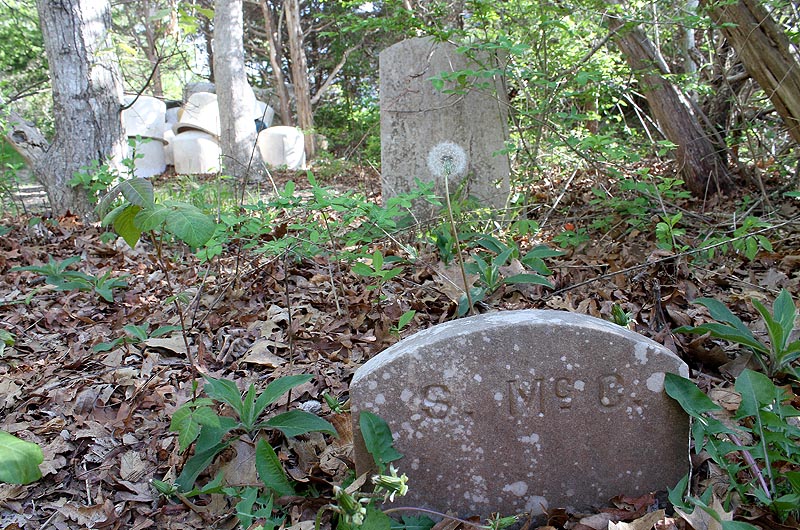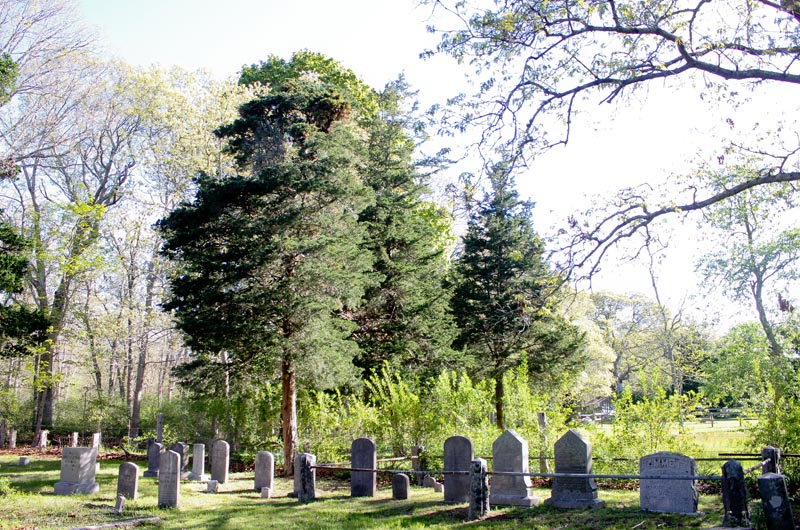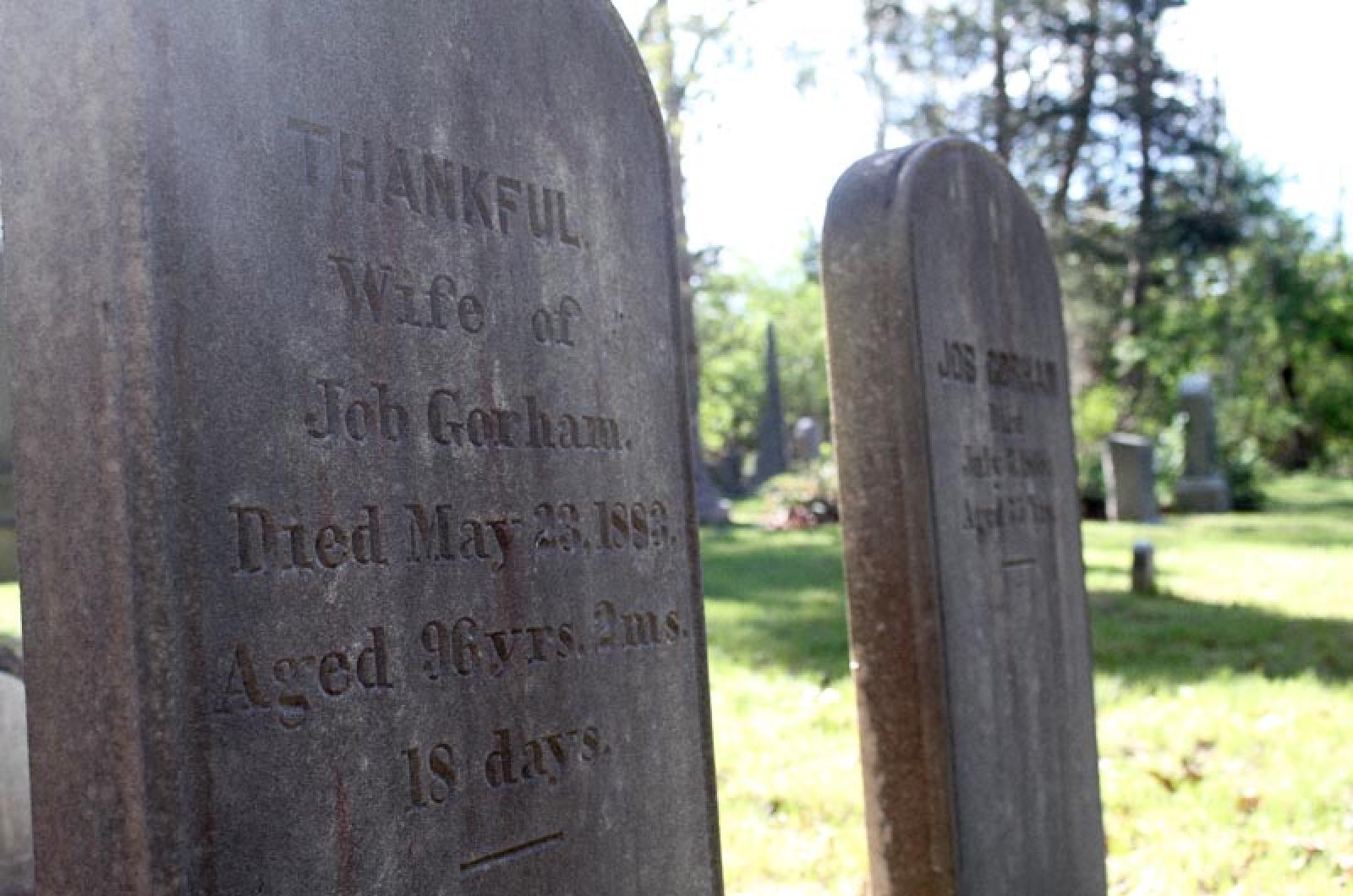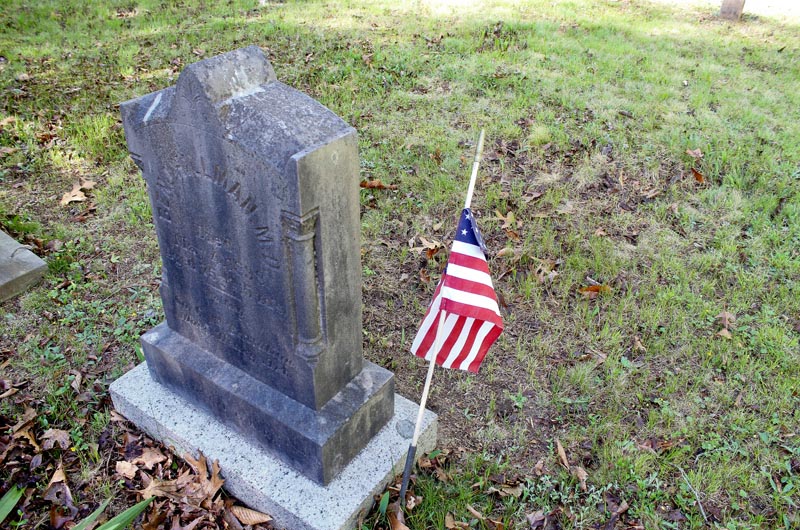The headstone reads Mrs. Sarah Wilbur. Born April 15, 1792. Died March 20, 1875. The eight is carved so it looks somewhat like an S; the circles don’t join up entirely, either. The stone itself is in great shape, though, largely unmarred by lichen. Just behind Mrs. Wilbur’s headstone is a smaller stone — the footstone. It is slightly askew, and bears the initials S.W.
Mrs. Wilbur isn’t buried in a cemetery, though. Her gravesite is in the woods near Major’s Cove, at what was once a farm. Mrs. Wilbur was born a Norton and is buried about 200 yards from the site of her home, according to Catherine Mayhew, genealogist for the Martha’s Vineyard Museum. But there’s no trace of farmland now, not anymore, what with the considerable forest growth around the site. From Mrs. Wilbur’s grave, you can also hear and see traffic now whooshing by on Edgartown-Vineyard Haven Road.
History is hidden all over the Vineyard. Forgotten gravesites still turn up in backyards, Mrs. Mayhew said. In fact, in the earliest years after English settlement most people were buried on their own property. Their graves are often discovered when homeowners embark on renovations, or casually turn over a stone that’s always been on the property, finding on the other side a small record of a life once lived.
Sometimes there is just one stone. Other times, as in the case of Seth Daggett and Elizabeth West, buried near the Tashmoo Overlook, there are two, for a husband and wife. And in some cases, there are whole cemeteries hidden away or left behind when the landscape around them shifted.
It took a three-year effort, led by retired Coast Guardsman Ted Coates, to clear the site of the old Marine Hospital cemetery in Vineyard Haven. The cemetery had its first burial in 1888 and has some 76 seamen interred there, all in graves marked with nothing but a number. The sailors were all from off-Island. They had died at the Marine Hospital and were buried well away from the site so their infections would not contaminate the living. Letters were sent to their families from the Seamen’s Bethel chaplain in Vineyard Haven. Over time, their final resting place was covered over. Thanks to Mr. Coates there is now a plaque at the cemetery matching names with numbers.
Elaine Cawley Weintraub spearheaded her own effort in the 1990s to clear a cemetery site adjacent to the parking lot of the state lobster hatchery. The cemetery was so hidden that a visit to the site in 1983, as part of a Gazette reporter’s review of a Field Guide to the Old Burying Grounds of Cape Cod, Martha’s Vineyard and Nantucket, turned up nothing at all.
“There is an unexpected reference to a very small plot across from the lobster hatchery, but a recent investigation uncovered more ticks than gravestones,” the author wrote.
When Mrs. Weintraub first heard about the cemetery, she was trying to find the gravesite of Rebecca Michael, the mother of the Island’s first African American whaling captain. Her research had turned up a reference to Rebecca’s funeral held near Eastville, and the lobster hatchery cemetery, also a former Marine Hospital cemetery, was a logical site.

“It kind of made sense that this was the place,” Mrs. Weintraub said. “It was where you put everybody who had nowhere else to be.”
“The cemetery at the time was almost completely obliterated,” she added. “All the lobster hatchery stuff was piled there. There were huge water containers from an experiment MIT had done some years before. So to get admittance to it you had to squeeze between them.”
Mrs. Weintraub led a community effort to clear the area, uncovering gravestones as she went. Many were knocked down. More had been lost to erosion. Today there are just three gravestones there. Two stones honor sailors who died at sea, and the third, covered in lichen, is unreadable. There is also a memorial bench installed in honor of Rebecca Michael.
“The idea was at least, you can sit and reflect and think about [the past],” Mrs. Weintraub said. “It’s our story, isn’t it? And the story of those who came before us and what they did and who they were and it seems like the most basic thing, to take care of it.”
•
At one point in time, Rogers Path in West Tisbury was a main road.

This is a difficult prospect to imagine nowadays. The main road is State road, two-laned, paved and painted with a double yellow line down the middle. Rogers Path is just the opposite: a small dirt lane off State Road, narrow and somewhat dusty with tall trees pressing in on both sides. On a recent May morning dogs barked near a house and birds tweeted in the trees overhead. A jogger in sunglasses emerged from a grass-covered extension of the path and continued on his route. A rooster crowed.
There is one indication of the dirt road’s former status, though, and that is the small plot of land a quarter-mile down the path, where it bends north. There is a fence and hedges, and the broken-off stems of the hedges indicate they’ve been pruned recently. This is Middetown Cemetery.
Town cemeteries are always near a road, said West Tisbury cemetery superintendent John Alley. And they’re often near a church. Rogers Path connected the cemetery to a church, most likely a Baptist one, according to both Mr. Alley and Mrs. Mayhew, that no longer exists. But the cemetery remains.
The names in Middletown Cemetery are old ones: Luce, Look, Skiff, Norton, Allen, Cleaveland, Hammett. But the cemetery gets no mention in Charles Banks’ lengthy three-volume history of the Vineyard. The dates on the stones are 1874, 1867, 1889, all the way up to 1933 and 1947.
Middletown has been closed since about the early 1960s. It is still maintained by the town, although it’s mowed less frequently than the larger cemeteries in town, Mr. Alley said.
Keeping the cemetery maintained is “a sign of respect to the folks that are interred there,” he said.
In the southeast corner of Middletown cemetery there is a dark marble stone sitting atop a lighter-colored flat slab. Carved into the dark marble is the name Benj. Hillman MD. Dr. Hillman lived but did not die here. He passed away at the age of 75 after “a short illness,” at his home in New Bedford, according to a 1898 Gazette account. But his remains were brought back to the Vineyard, and his gravesite is marked by a small American flag in the ground. It is the only site at Middletown that bears any sort of marking from the current era.
Dr. Hillman was part of Company C of the 1st battalion of the Massachusetts Heavy Artillery unit in the Civil War, which was stationed at Fort Warren in Boston. On Veterans Day and Memorial Day, West Tisbury veterans’ officer Brian Athearn visits each serviceman’s grave in town and plants a flag. Never mind that Middletown is hidden away, and its lone veteran long passed.
“As long as people remember you, you’re there,” Mrs. Mayhew said.








Comments (2)
Comments
Comment policy »